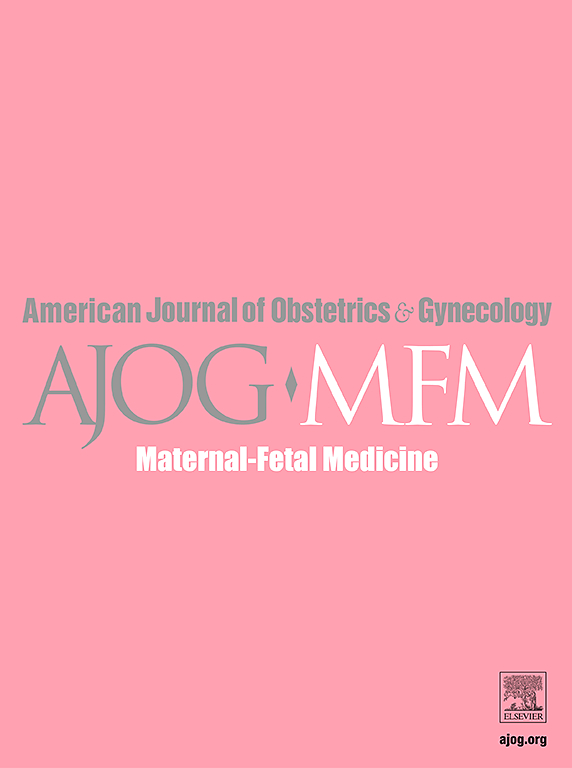Stillbirth is associated with postpartum severe maternal morbidity compared with gestational age matched and term live births
IF 3.1
2区 医学
Q1 OBSTETRICS & GYNECOLOGY
American Journal of Obstetrics & Gynecology Mfm
Pub Date : 2025-06-12
DOI:10.1016/j.ajogmf.2025.101725
引用次数: 0
Abstract
BACKGROUND
The rates of severe maternal morbidity in the United States continue to increase. The American College of Obstetricians and Gynecologists recommends close postpartum follow-up for patients at increased risk for severe maternal morbidity and mortality, such as those who suffer from preeclampsia or hypertension. Data on the association between stillbirth and severe maternal morbidity are limited.
OBJECTIVE
This study aimed to evaluate the association between stillbirth and severe maternal morbidity in comparison with gestational age–matched and term live births.
STUDY DESIGN
This was a multicenter, retrospective cohort study that was performed at 3 centers within a hospital system from 2017 to 2023. Severe maternal morbidity was defined with guidance from the indicators outlined by the Centers for Disease Control and Prevention. The inclusion criteria for the stillbirth group were delivery of a fetus that showed no signs of life at 20 weeks’ gestation or later. Cases with antepartum preeclampsia, multiple gestations, maternal age less than 18 years, duplicate records, and voluntary terminations of the pregnancy after 20 weeks’ gestation were excluded. We selected gestational age- and term-matched live births as the control groups. A logistic regression analysis was performed to evaluate the odds of the composite severe maternal morbidity in stillbirths vs gestational age–matched and term-matched live births, separately, with adjustment for potential confounders. The data were presented as the adjusted odds ratios with 95% confidence intervals, and statistical significance was set at a P value of <.05.
RESULTS
Of the 29,060 deliveries during the study period, there were 129 (0.44%) stillbirths. Stillbirth was associated with significantly higher odds of severe maternal morbidity than term (adjusted odds ratio, 4.35; 95% confidence interval, 1.75–10.84) and gestational age matched livebirths (adjusted odds ratio, 3.39; 95% confidence interval, 1.72–6.66). There was no significant difference in the rate of postpartum hemorrhage when stillbirths were compared with gestational age–matched live births (10.1% vs 7.3%; P=.42), however, there were significantly more transfusions needed in the stillbirth group (10.1% vs 1.6%; P=.017). When compared with the term live births, there were significantly more transfusions (10.1% vs 1.6%; P<.001), intensive care admissions (2.3% vs 0%; P=.007), postpartum preeclampsia (2.3% vs 0%; P=.007), and sepsis (2.3% vs 0%; P=.007).
CONCLUSION
Stillbirth is associated with an increased risk for severe maternal morbidity when compared with gestational age- and term-matched live births. Increased postpartum surveillance should be implemented into practice, and preventative interventions, such as tranexamic acid administration, should be evaluated further in prospective studies.
与胎龄匹配和足月活产相比,死产与产后严重产妇发病率有关。
背景:美国严重孕产妇发病率持续上升。ACOG建议对严重孕产妇发病和死亡风险增加的患者,如患有先兆子痫或高血压的患者,进行密切的产后随访。探讨死产与严重孕产妇发病率之间关系的数据有限。目的:评价死产与胎龄匹配和足月产之间的关系。研究设计:这是一项多中心回顾性队列研究,于2017-2023年在医院系统内的三个中心进行。SMM是在疾病控制中心概述的指标指导下定义的。死产组的纳入标准是在妊娠20周或以后分娩的胎儿没有生命迹象。排除产前先兆子痫、多胎妊娠、产妇年龄小于18岁、重复记录和妊娠超过20周的自愿终止妊娠。我们选择胎龄和足月匹配的活产作为对照组。分别进行Logistic回归来评估死产与胎龄匹配和足月匹配的活产的复合严重孕产妇发病率的几率,同时调整潜在的混杂因素。数据以校正后的优势比(aOR)表示,95%置信区间(CI),统计学显著性设置为P < 0.05。结果:在研究期间的29,060例分娩中,有129例(0.44%)死产。与足月相比,死产与严重孕产妇发病的几率显著更高(aOR = 4.35,95% CI 1.75-10.84),胎龄与活产相匹配(aOR = 3.39,95% CI 1.72-6.66)。死产组和胎龄匹配的活产组的产后出血发生率无显著差异(10.1%比7.3%,p = 0.42),但死产组需要的输血量明显更多(10.1%比1.6%,p = 0.017)。与足月活产相比,输血量明显增加(10.1% vs. 1.6%)。结论:与胎龄和足月匹配的活产相比,死产与严重孕产妇发病风险增加相关。加强产后监测应付诸实践,预防性干预措施,如氨甲环酸的施用应进一步评估与前瞻性研究。
本文章由计算机程序翻译,如有差异,请以英文原文为准。
求助全文
约1分钟内获得全文
求助全文
来源期刊

American Journal of Obstetrics & Gynecology Mfm
Medicine-Medicine (all)
CiteScore
7.40
自引率
3.20%
发文量
254
审稿时长
40 days
期刊介绍:
The American Journal of Obstetrics and Gynecology (AJOG) is a highly esteemed publication with two companion titles. One of these is the American Journal of Obstetrics and Gynecology Maternal-Fetal Medicine (AJOG MFM), which is dedicated to the latest research in the field of maternal-fetal medicine, specifically concerning high-risk pregnancies. The journal encompasses a wide range of topics, including:
Maternal Complications: It addresses significant studies that have the potential to change clinical practice regarding complications faced by pregnant women.
Fetal Complications: The journal covers prenatal diagnosis, ultrasound, and genetic issues related to the fetus, providing insights into the management and care of fetal health.
Prenatal Care: It discusses the best practices in prenatal care to ensure the health and well-being of both the mother and the unborn child.
Intrapartum Care: It provides guidance on the care provided during the childbirth process, which is critical for the safety of both mother and baby.
Postpartum Issues: The journal also tackles issues that arise after childbirth, focusing on the postpartum period and its implications for maternal health. AJOG MFM serves as a reliable forum for peer-reviewed research, with a preference for randomized trials and meta-analyses. The goal is to equip researchers and clinicians with the most current information and evidence-based strategies to effectively manage high-risk pregnancies and to provide the best possible care for mothers and their unborn children.
 求助内容:
求助内容: 应助结果提醒方式:
应助结果提醒方式:


